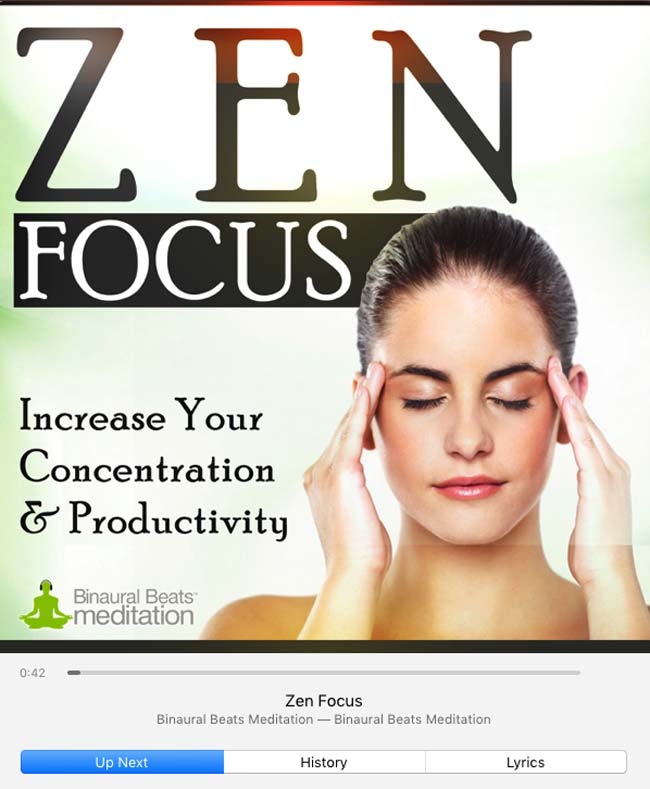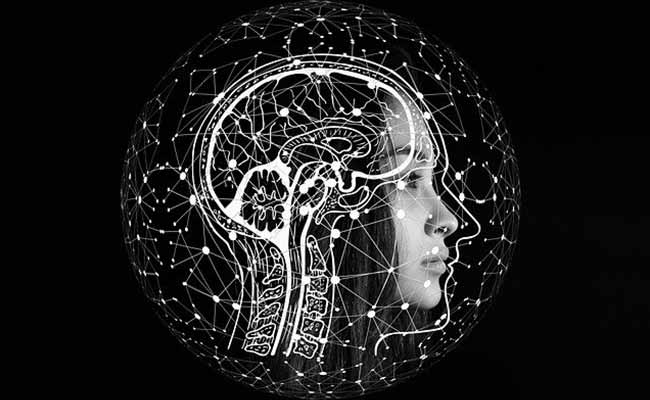If there's one area that binaural beats really come into their own it's increasing focus and improving work productivity.
If, like me, you work at home, getting settled and being productive can be a challenge.
And if you work on a computer in an office, you'll know just how difficult it can be to block out all distractions and get into the “Zen Zone”.
The great thing about binaural beats is they can help you access that ‘flow state' people rave about. I'm referring to that state of mind where your fingers are literally dancing across the keyboard and you're getting things done at a phenomenal rate.
When we access this state it's like we can get 4 hours work done in an hour. It's that super-productive state that you look back on in the evening and feel pumped that you got so much done – vs. feeling like it was another wasted day…
So whether it's an essay you need to get finished, a challenging work project that requires your maximum focus, studying for a course or exam, or even finishing a painting or blog post, you can use binaural beats as a focus and productivity aid.

Where ever you are, slip in your headphones and zone into your work.
How Binaural Beats Help You Focus
Let me run through a quick overview of how this works, without getting too technical.
Okay, so it is generally accepted that there are 5 major brain states, and while it is somewhat simplified, let's categorize them like this:
- Delta: Sleep, pain relief, access to sub-conscious mind
- Theta: Deep relaxation, meditation, creativity, healing
- Alpha: Flow state, positive thinking, concentration, focus
- Beta: high energy, high-level learning, memory enhancement
- Gamma: Very high energy, memory recall, peak awareness
So here's the thing: If you're tired and feeling a tad lethargic, then your brainwave makeup is probably being dominated by Theta waves.
Conversely, if you're distracted and your brain is moving at 100 kph, then you're probably firing a lot of high-end Beta and Gamma waves.
Again, I'm generalizing a fair bit here for the sake of a quick explanation.
Neither of these states of mind is ideal for high-level concentration.
When we want to be fully immersed in a feeling of energized focus, full involvement, and enjoyment in the process of the activity, we need to move into the Alpha state and produce more Alpha brainwaves.
Binaural beats can help us do that because they induce a process called ‘frequency following response'. This is when the brain is triggered to follow along at a particular frequency.
The Frequency Response Process
Okay, so here's how this process works.
You put on a pair of headphones and press play.
- The left headphone sends a frequency to the left ear. Let's say 210 Hz.
- The right ear sends a frequency to the right ear. Let's say 220 Hz
- The brain then calculates the mathematical difference between the two frequencies, which is 10 Hz (Alpha), and follows along at that frequency.
You see, the brain technically produces a third frequency, which is a convergence of the two frequencies it received from the left and right ears.
The Alpha state runs between 8-12 Hz. So any frequency within this range is an Alpha frequency.
Tracks I Use for Focus
So it's Alpha tracks you should be listening to for concentrating while typing, writing, studying, painting, doing woodwork, whatever activity it is that requires you to block out the world and engage your brain for optimal potential.
I really like using the 3 tracks below:
- Zen Focus (perfect for working)
- Flow State (Great for facing difficult challenges)
- Deep Concentration (Good for centering an overactive mind)
How I Listen…
Because I work on the computer a fair bit, I download the tracks to my computer, drop them into iTunes and plug my headphones into my computer.
I then have the option of transferring them over to my iPod (yes, I still have one), or my phone if need be.
I tend to listen to 30 minutes or 1-hour at a time, then take a break, grab a drink and then do another hour if I need to. After an hour I'm usually fully entrained into the zone and so immersed in what I am doing I can keep going without the music.
I use either my Beyerdynamics DT 770 Pro or my iPod headphones. The Beyer are closed-back and really insulated, so if I listen for more than an hour I'll switch to the lighter weight earbuds.
On a side note though, closed-back headphones definitely enhance the process and promote an isolated feeling of being closed off from external distraction.
With this type of headphone the sound is unable to leak in from your immediate environment. The music also sounds warmer an gives you an in-head sound experience.

I mostly listen through iTunes on my computer, and sometimes my iPod or phone.
How Long Does it Take to Work
If it's your first time listening, then you'll feel the effects pretty quickly – though results will differ from person to person. Certainly by the 15-minute mark you should be immersed and flying along with your work.
Note that the minimum suggested listening time is 15 minutes. If you need to break and grab a drink or go to the bathroom, just press pause and come back to the session.
Other Tips
It's worth having a few different tracks to choose from because after a week or so I'm sure you'll fancy listening to something new.
You might also want to take a break after 2 or 3 weeks of daily use, as your brain can start to get used to the effects.
I also recommend doing things that are conducive to enhancing your focus and concentration. For example, you might do the following:
- Put your phone on silent.
- Close Facebook in your web browser.
- Eliminate external noise: close the window, turn off the radio, etc., though headphones will stop most of this noise pollution.
- Let others know not to disturb you.
The reason I say this is that you don't want to pull your mind in two different directions. For example: if the binaural beats are taking your brain into the Alpha state, yet you keep checking your phone or intermittently reading Facebook posts, you are stimulating your mind and causing confusion as to the state of mind you want to be in.
I have an FAQ that covers a lot more information on getting the most out of your binaural beats listening experience. You can read that here.
Other than that there's nothing to it. Simply slip on your headphones and press play. It's that easy.



Cotton says
Don’t feel that you have to answer now. I have read more, discovered the links in your text will lead to more useful information and the missing pieces are clearing up. The download from BBM was not as fraught as I had imagined. Thank you
bbfreak says
Hi Cotton, I did reply, hope you got my message.
Cotton says
I did thank you.
Now I have more questions. Since reading, I’ve forwarded to so many. A cousin has a grown child in icu from a spider bite, might be helpful, so you would think hospitals would use/offer to help patients.
How do binaural and solfeggio differ in effectiveness. I do understand that binaural is different in each ear. Is solfeggio mono? Or meant to be played “ for the room”
using a speaker?
bbfreak says
Hi Cotton,
Binaural beats and solfeggio frequencies are two different things.
1. Binaural beats are an audible phenomenon that occurs when two slightly different frequencies are presented separately to each ear. For example, if a tone of 400 Hz is presented to one ear and a tone of 410 Hz is presented to the other ear, the listener perceives a third tone that is the difference between the two frequencies (in this case, 10 Hz). This perceived third tone is the binaural beat.
The brain synchronizes its electrical activity to the frequency of the binaural beat, a process known as entrainment. Binaural beats require headphones for the effect to take place.
2. Solfeggio frequencies are a set of ancient musical frequencies derived from the Gregorian chants and based on a six-tone scale known as the Solfeggio Scale. The frequencies in the scale are 396 Hz, 417 Hz, 528 Hz, 639 Hz, 741 Hz, and 852 Hz. And three additionally identified frequencies: 174, 285, 963. Each frequency is said to have specific healing properties and spiritual significance. For example, 528 Hz is often associated with DNA repair and transformation, while 417 Hz is believed to facilitate change and undoing negative situations.
In a solfeggio track it is the composition itself that is created in a particular frequency (pitch), so it is normal stereo music information. However, many creators also put some form of frequency tone (matching the desired frequency) underneath the music for additional effect, usually a monaural tone, which can be listened to with or without headphones.
Cotton says
Ps. The third thing I wanted to ask was about the cicadas. Have you determined their frequency? What is that frequency’s effect?is it a cool gift or nothing
Here, it sounds like an 50’s soundtrack from a ‘Mars Invasion’ movie
bbfreak says
Not sure what this is?
Kushal says
Why wouldn’t you use Gamma waves? I can’t decide if a 7.5Hz tone or 50Hz tone is going to be better for optimal focus, productivity, execution, especially in software engineering / programming tasks.
bbfreak says
You want to be in the flow state. Alpha is perfect for this. Have a look at this: https://www.binauralbeatsmeditation.com/product/flow-state/
Kinga says
How about listening to Beta binaural beats?
“14 Hz – An awake, alert state. Allows you to focus and concentrate on tasks.
15 Hz – 18 Hz – Increases your mental abilities including focus, alertness, attentiveness and IQ. You are aware of yourself and surroundings and are alert but not agitated”
I’m not an expert and I had the same problem. I listen Theta every day during morning meditation but Alpha did not work for me – I feel normal.
bbfreak says
Alpha is associated with the Flow State (optimal state of consciousness where we feel our best and perform our best). It’s good for concentrating, for focus and getting in the zone. Much of your experience will depend on the recording you’re listening to. You need to experiment. I often use Zen Focus while working to block out distraction and get productive.
Kings says
Thank you for your reply. You are absolutely right. I tried a different recording (isochronic tones) and I could feel that Alpha state is working.
I also tried Gamma (for ADD), but usually fell asleep or felt nothing. I will try Zen Focus.
Pär says
I use zen focus for anxiety. You don’t get distracted. Works great 😄
bbfreak says
It does, I use it too 🙂
Chris says
Hi Lawrence! Your blogs have been incredibly helpful and insightful. Today I decided to make myself a 14 Hz binaural beat and wow has it been a game changer! I feel like the 14 Hz binaural beats have helped give me back my focus, energy, and motivation!
For example, today I went to the park and did so much intense exercise that my body is now sore. That never happens to me. I also did some college work worth over 120 questions. I even drew something. Yup, I’d say today has been a productive day. Where have these binaural beats been in my whole life? Truly a life changer.
bbfreak says
Awesome! That’s amazing to hear! Sounds like you had an ultra-productive day! 💪
Try some higher frequency Gamma for even more energy 🙂
Chris says
Okay so I decided to give gamma a shot. Made myself a 40 Hz binaural beat and woah!! It really does enhance your cognition! I used to make these binaural beats at 50 Hz and now am starting to think that it was all placebo. But this? This 40 Hz binaural beat? It’s legit!
I assumed the difference between both tones would be picked up as two totally separate tones by the brain. Guess I was wrong! What would you say is the limit before your brain perceives them as two tones instead of a binaural beat?
bbfreak says
Well a 40 Hz binaural beat has some solid science behind it, but in my experience the cut-off is probably somewhere between 40-50 Hz. I also read that it can be person-dependent. Great to hear your experimentation is going so well.
Chris says
Check it! I found some blogs promoting the use of binaural beats at 60 Hz and 75 Hz.
upwardtogether .art /mindfulness/achieve-peak-focus-with-60-hz-gamma-binaural-beats-and-essential-tools
upwardtogether. art /mindfulness/unlocking-focus-and-self-care-with-75-hz-gamma-binaural-beats
bbfreak says
It’s a bit too high according to the science, because at this frequency the tones would be perceived by the brain as a single combined tone. The difference is too fast for the brain to register as a separate pulsing beat.
Chris says
I agree. I’m gonna stick with 40 Hz. Thanks!